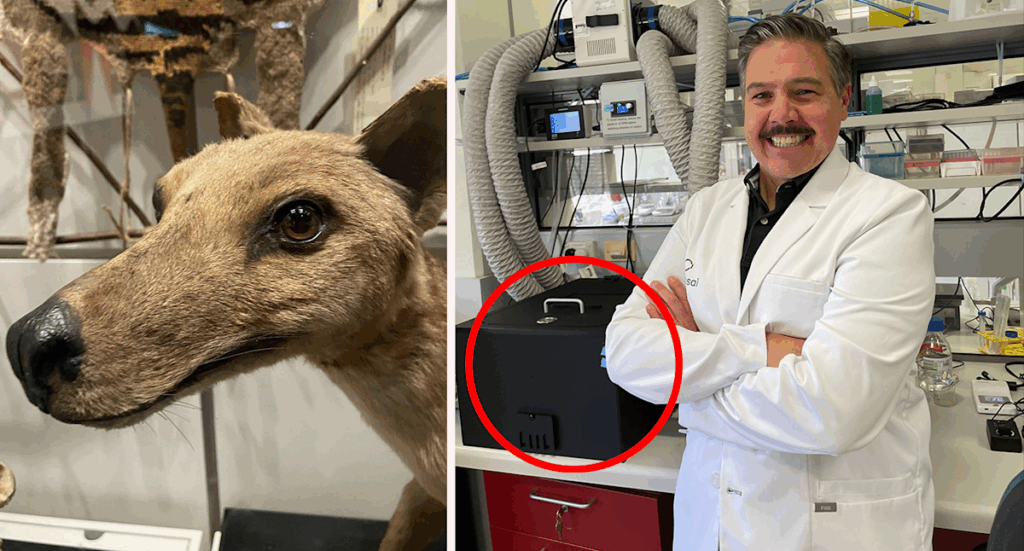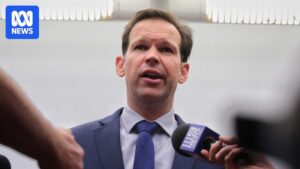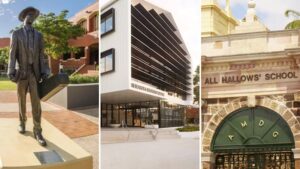
Investment by Colossal Biosciences into an Australian lab to help recreate extinct animals could have major ramifications for living species, including humans. As Colossal Bioscience’s new Chief Biology Officer, Professor Andrew Pask will be overseeing the development of new technology like this artificial womb. Source: Colossal Biosciences.
Australia is now central to plans to bring animals back from extinction and protect those on the brink, with the announcement of a major investment of US funds that’s “substantially into eight figures”. Texas-based biotech company Colossal Biosciences, which is working to recreate the Tasmanian tiger (thylacine), woolly mammoth, dodo, and moa, is expanding its research laboratories at Melbourne University and has appointed a local expert to oversee strategies for its de-extinction projects.
Charismatic scientist Professor Andrew Pask, who has led the company’s world-famous thylacine genomic research, is now the company’s global chief biology officer. Speaking to Yahoo News Australia, he said the investment in Australia made sense as the nation has the worst extinction rate of mammals in the world. “The risk to our wildlife in particular is extreme,” he said.
De-Extinction and Conservation: A Dual Approach
Because de-extinction is “enormously expensive”, there are only a few rare cases in Australia where the technology will be used. A more immediate impact of the company’s scientific developments will be altering existing species to protect them from threats like changing weather patterns and introduced species, or even breeding them up in artificial wombs.
“Part of the problem with issues around loss of biodiversity is that there are so many spot fires burning all over the place, and it’s really hard to know where to focus your attention. But one of the fantastic things about this work we do with Colossal is that they have brought serious funding,” Pask said.
Today, the only place you can see a thylacine is at institutions like Melbourne Museum. But Colossal Biosciences wants to recreate the species and release it into the wild. Source: Michael Dahlstrom.
Thylacine Technology: A Potential Lifeline for Endangered Species
The DNA engineering technologies developed as part of the thylacine de-extinction project are being used to design resistance for a toxin killing off the northern quoll. This rare predatory marsupial is at risk of being wiped out as invasive cane toads continue to spread across Australia, killing off native species that bite on their poisonous glands.
“It’s predicted to go extinct in the wild within the next 10 years if we can’t make these [gene] edits and get our animals out there,” Pask said.
His team has also been working to genetically engineer frogs so they can resist deadly chytrid fungus, which is responsible for the extinction of at least seven Australian species. “[Colossal] is really moving the needle in terms of the conservation space,” Pask said.
Restoring Ecosystems and Historical Context
When it comes to de-extinction, Pask is driven by a need to restore damaged ecosystems. There are animals he’d like to see returned to Australia’s landscape, including the pig-footed bandicoot and the Toolache wallaby — a species that was seen in colour film for the first time this year, following an investigation by Yahoo News.
But the focus has been on the thylacine because its extinction had a bigger impact on the environment. The loss of this apex predator has led to an imbalance in Tasmania where sick and weak animals aren’t killed off. This has led some scientists to speculate this problem led to the spread of facial tumour disease in the Tasmanian devil which almost led to its extinction.
“We’re really shifting the focus now from learning a lot about old genomes, extinct species and lost diversity, to actually bringing those animals back into existence. And that’s the whole path where biology really plays a role,” Pask said.
New Tools for Marsupial Recovery
Under the new agreement, Melbourne University’s Thylacine Integrated Genomic Restoration Research Lab (TIGGR) will be renamed Colossal Australia, and its laboratories have been revamped. The investment will be key to Australia’s development of artificial gestation. This will include growing embryos in culture, placing them in artificial wombs, transferring them to artificial pouches, and feeding them artificial milk.
Currently, they can do each stage of marsupial pregnancy in pieces, but not as a continuous stream. And the wombs are undergoing a dramatic revamp due to concerns about its “naff” appearance. “It’s like a black box with a rotating thing. It looks incredibly underwhelming, but what we can achieve with it is mind-blowing,” Pask said.
Once fully developed, Pask believes these wombs could be a “game changer” for growing and releasing depleted species en masse back into the wild, like Tasmanian devils. Or re-establishing populations of animals after major disasters, like the Black Summer Bushfires, which impacted over 60,000 koalas and led to major populations being listed as endangered.
“After we’ve had a catastrophic bushfire or flood, we would be able to create 1,000 koalas with the exact genetic diversity from a particular region and then rear them without the need for having surrogate mums in captivity to rear them,” Pask said.
“You’d be able to do that basically in culture, and then release them back into the wild. I think that’s got massive implications for how we might manage koalas going forward.”
Implications for Human Health and Future Prospects
Bringing back birds is more difficult because once they’ve genetically engineered a cell, it can’t yet be turned into a living bird. To date, most of the artificial womb research has been focused on dunnarts. But they have also completed some work on pigs and mice, with a focus on different-sized animals.
The team believes the technology could eventually be “incredibly useful” for the conservation and gestation of non-marsupial mammals. It could be used to generate livestock species to help feed the world’s growing human population.
“But also things like human-preterm birth. There are a lot of health implications for babies who were born very prematurely, and being able to have proper artificial wombs would be an amazing breakthrough,” Pask said.
Love Australia’s weird and wonderful environment? 🐊🦘😳 Get our new newsletter showcasing the week’s best stories.







